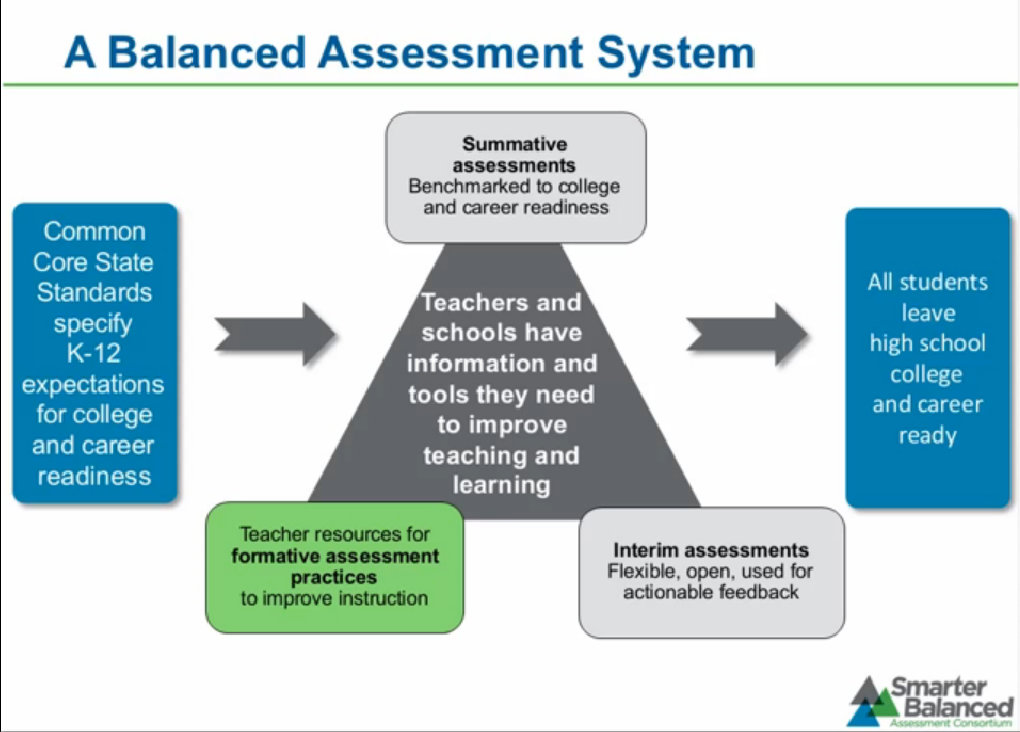Introduction to Next Generation Assessments
| Site: | Alma |
| Course: | TRIG: Classroom Readiness T3 |
| Book: | Introduction to Next Generation Assessments |
| Printed by: | Guest user |
| Date: | Thursday, January 1, 2026, 2:41 PM |
National Assessment Consortia
 |
 |
There are two groups working to develop next generation assessments that accurately measure student progress toward college- and career-readiness: Smarter Balanced Assessment Consortium (SBAC) and Partnership of Readiness for College and Careers (PARCC). These consortia were awarded funding from the U.S. Department of Education in 2010 to develop an assessment system aligned to the College and Career Readiness Standards by the 2014-15 school year.
After exploring the next generation assessments web sites linked below, you'll be asked to reflect upon and respond to the following:
- What impact does the timeline have on your students and instructional practices?
- List at least three (3) issues or ideas you read about that were new knowledge for you.
Visit: Smarter-Balanced Assessment Consortium Website
Visit: Partnership for Assessment of College and Career Readiness Website
Activity 4.01
After exploring the next generation assessments web sites, respond to the following in your Module 04 - Google Document:
- What impact does the timeline have on your students and instructional practices?
- List at least three (3) issues or ideas you read about that were new knowledge for you.
Next Generation Assessments

The Next Generation Assessment system—including summative, interim, and formative components—is designed to accurately measure student achievement and growth toward college- and career- readiness.
These assessments will go beyond multiple choice to include performance tasks that allow students to demonstrate research, writing, and analytical skills. The assessments are designed to give teachers the feedback they need to guide instruction, and the tools to improve teaching and learning.
In addition to a year-end summative assessment, Next Generation Assessments will include optional interim assessments that allow teachers to measure student progress throughout the year. Results from the interim assessments will provide a better understanding of each student’s strengths and weaknesses. Teachers will have the flexibility to access student results and supporting resources as needed through a secure, online system.
Computer Adaptive Testing
The Next Generation Assessment system capitalizes on the precision and efficiency of computer adaptive testing (CAT) for both the mandatory summative assessment and the optional interim assessments. Based on student responses, the computer program adjusts the difficulty of questions throughout the assessment. For example, a student who answers a question correctly will receive a more challenging item, while an incorrect answer generates an easier question. By adapting to the student as the assessment is taking place, these assessments present an individually tailored set of questions to each student and can quickly identify which skills students have mastered. This approach represents a significant improvement over traditional paper-and-pencil assessments used in many states today.
Assessment Item and Task Types
The Next Generation Assessment system includes a variety of item types. Developers are exploring different response options for mathematics problems, including innovative uses of tablet technology. The response formats included in the sample items will be updated based on findings from cognitive labs and small scale trials being conducted this fall, as well as additional information gathered during pilot testing in early 2013.
- Selected-response items
prompt students to select one or more responses for a set of options.
options. - Technology-enhanced items
take advantage of computer-based administration to assess a deeper understanding of content and skills than would otherwise be possible with traditional item types. Technology-enhanced items capitalize on technology to collect evidence through a non-traditional response type, such as editing text or drawing an object. Selected-response and technology-enhanced items can be scored automatically. - Constructed-response items
prompt students to produce a text or numerical response in order to collect evidence about their knowledge or understanding of a given assessment target. - Performance tasks
measure a student’s ability to integrate knowledge and skills across multiple standards—a key component of college and career readiness. Performance tasks will be used to better measure capacities such as depth of understanding, research skills, and complex analysis, which cannot be adequately assessed with selected- or constructed-response items. Some constructed-response items and performance tasks can be scored automatically; many will be hand-scored by professionally trained readers.These tasks will be delivered as part of the interim and summative components of the assessment system.
Hardware/Software Requirements
The Smarter Balanced Technology Strategy Framework and System Requirements Specifications provide minimum hardware specifications and basic bandwidth calculations that will allow schools and districts to evaluate which of their existing computers will support the administration of the assessment system in the 2014-15 school year.
The framework was developed with input and feedback from Smarter Balanced member states, work groups, and data from the Technology Readiness Tool, an online inventory of technology resources launched in 2012. Based on the research and data analysis, Smarter Balanced estimates that the majority of schools and districts in member states will be able to successfully administer the assessments with their existing infrastructure.
Activity 4.02
After reviewing the hardware/software requirements, answer the questions below in your Module 04 - Google Document:
- What devices do you have in your school/district?
- Locate someone who has piloted with similar devices and interview them about what worked/what didn’t/etc.
- How can you help the (or your) district technology team with future purchases?
- How do you plan on building a learning environment that encourages any time, any place learning (ATAP)?
- What steps can you take to ensure that devices purchased for your school/district are not only used during the testing window but also used for ATAP learning?
You are now ready to move on to the next activity: Connecting Next Generation Assessments to the Standards